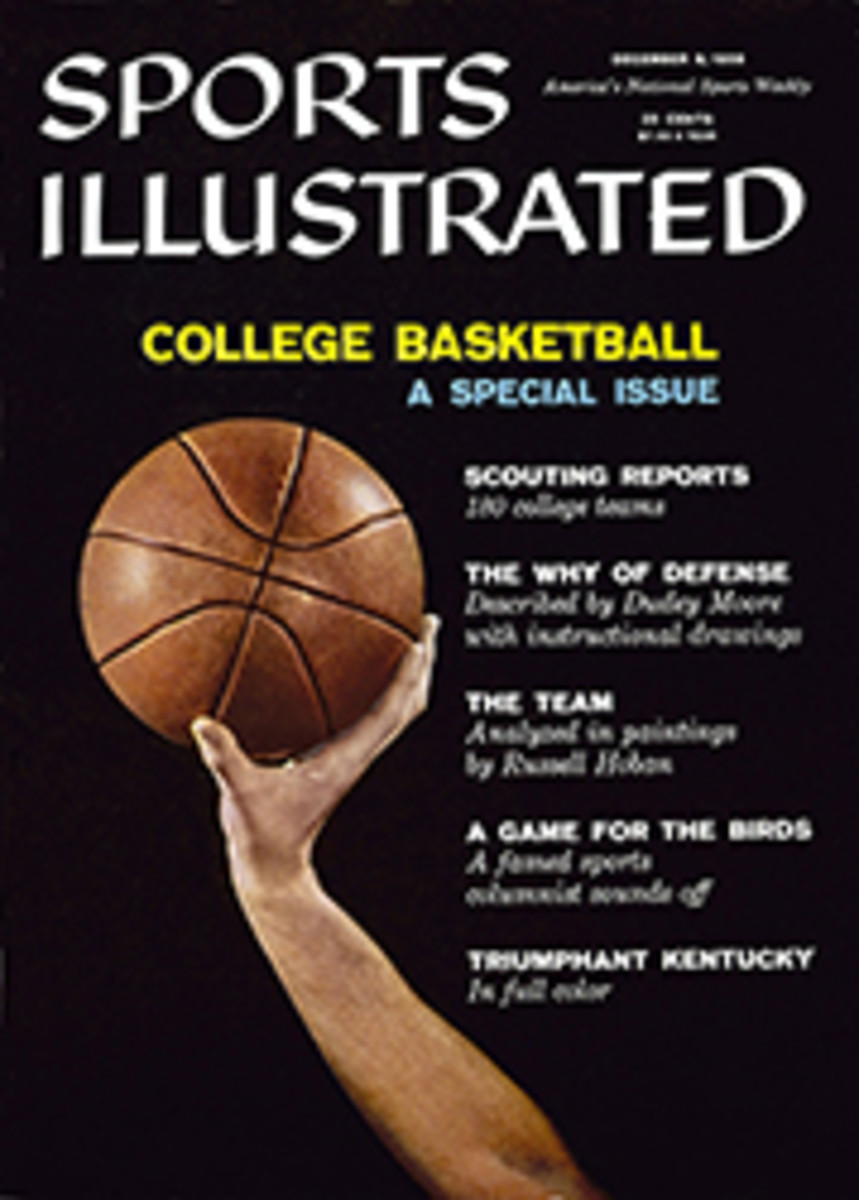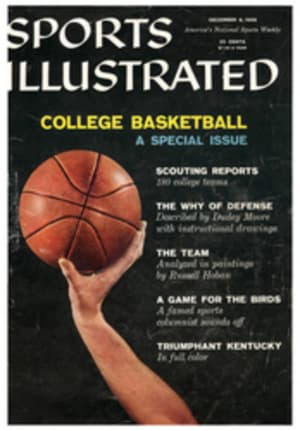
Taking calculated risks on defense often can win games. Here, a coach long famous for his use of such aggressive tactics explains why a DARING DEFENSE PAYS OFF
THE AUTHOR: Donald Wilson "Dudey" Moore is a stocky, amiable 48-year-old of generous spirit and ready wit. Now in his first season as coach at La Salle College in Philadelphia after 10 highly successful years at Duquesne, he possesses a durable reputation, not only as a fine and decent man, but as one of the nation's most perceptive teachers of the sometimes misunderstood and unappreciated art of defensive basketball. In a decade of handling Duquesne basketball teams, he compiled a record of 191 games won, only 70 lost, for a .732 percentage. In addition, his teams rolled up winning streaks of 16, 18 and 22 games. In 1952 and 1954 Moore was chosen college Coach of the Year by the United Press, and in 1955 his Duquesne team won the National Invitation Tournament. Records and honors aside, he produced such outstanding players as Chuck Cooper, Dick Ricketts, Jim Tucker and Sihugo Green. There is every reason to believe that more such are forthcoming at La Salle. He brings to these pages the lessons taught by 24 years in his profession.
The basic stance
The starting point from which to teach defensive basketball is the stance. I advocate the so-called boxer stance, as do most coaches, because it allows the defender to cover a greater amount of area, quickly, than any other. One foot is well forward. It doesn't really matter which, except when an opponent is being guarded along the side or end lines; then the forward foot must be the one nearest to the line to cut off that side as a possible driving lane. The other foot is back. The weight is evenly distributed on the balls of both feet, though the heels are still in contact with the floor. The body is bent at the waist and the knees well flexed to maintain good, aggressive position. The forward hand is raised and extended toward the opponent to harry and upset him as well as block his vision. The other hand is held at waist level, poised to block the passing lane on that side. Now, when the opponent drives toward the basket, the defender is ready for him. If his man goes to his right (top drawing, below) the defender pivots off his left foot, taking a quick step back (arrow) along the path of the drive with his right foot, his right hand reaching out to cut off a possible pass or dribble. If his opponent moves to his left (bottom), the defender pivots off his right foot, takes a long step back along the path of the drive with the left (arrow), swinging his left hand down into the lane to deflect a possible pass.
The vital floor position
Under most circumstances when guarding a man without the ball the defender should always stay between his man and the basket. Here defender (above, right) is devoting close attention to his man, but is also keeping an eye on the ball. If the ball is moved away from his man, he will "sag off," dropping back a little toward the basket to help jam up the middle lane. If the ball is moved into the area near his man, he must then move up closer, almost in direct proportion to the distance his man is from the ball. In the critical scoring area within 15 feet of the basket, I abandon this principle in favor of aggressively playing the ball. Here (below, right) an offensive player cuts toward the basket, but the defender, instead of staying behind him (and nearer the basket) moves in front of his opponent, trying to beat him to the desired position. The pass to the cutter under the basket must now be lobbed over the defender's head, a difficult trick, and it can often be blocked or intercepted. The risk involved in this tactic is that the defender may allow his man to get too far in back of him and thus be an easy target for a pass. I feel the gamble is worth taking. This kind of challenging defense pays off more often than not.
The pivot man
Trying to stop a good, big pivot man who takes up a position along the foul lane is one of the toughest defensive assignments a team can be asked to handle. The most effective way is to see that he doesn't get the ball too often, mainly by blocking off the passing lanes. The player (No. 10) assigned to guard the pivot man should play alongside and slightly in front of him. As the offensive team passes the ball from one side of the court to the other, the defender crosses over behind the pivot man, if he is out by the foul line, and in front if he is closer to the basket. This makes it more difficult for the offensive team to feed the ball to the pivot. Here another defensive player (right) helps out by sagging-off his own man, alert to protect against a pass which may be lobbed to the pivot man if he turns away from the defender and toward the basket, or to help tie him up if he does get the ball. It is evident that we are thereby risking the possibility that the third opponent (right) may receive the ball and have a clear outside shot, but this is far better than letting the pivot man have an easy close-in shot.
The time to gamble
An extremely significant part of my defense is a readiness to take risks in actually going for the ball when the occasion arises. This is the real meaning of aggressive defense. My players are taught to neglect their assigned men when they feel certain of being able to pull off a successful steal, intercept a dribble or pass or, at least, tie up the ball. Above, a defensive man, realizing that he has an excellent chance to succeed, has ignored his own man in an attempt to steal the ball from another offensive player. Even if he doesn't actually get possession, he will surely stall the opposition's plans by causing a jump ball. At the very worst, he has neglected a player who doesn't have the ball and so cannot score. Most coaches hesitate to teach this maneuver, but I have found the gain greater than the loss, that is, if the gamble is not a foolish one.
The switch is fundamental
The sudden changing of defensive assignments, known as switching, is a basic part of man-to-man defense. It is used to circumvent the blocks and screens set up by the offense. The two illustrations here, involving a pivot man stationed at the foul line, show a typical switching situation. The player with the ball dribbles directly in front of his teammate, so that the defender on the right is blocked off (left). Defender No. 34, since he must now shift to the ball, calls "Switch!" and moves quickly away from his man to pick up the dribbler (below). Meanwhile, No. 12 is now responsible for No. 11 and must move around him (arrow) as quickly as possible to protect against a pass from the man who still has the ball. Even if there is now an unequal height alignment on defense (as shown below), this switch should be maintained until it is safe to return to the original assignments. This kind of aggressive switching to the ball very often leads to a steal, and is especially effective in the critical scoring area close to the basket.
The check-out for rebounds
The defensive men must hold their proper positions as the ball leaves the shooter's hands (above). They wait until their men have begun to commit themselves for the rebound on particular paths toward the basket. Then they take quick cross-over steps into those paths (arrow, below), checking out the offensive players. Having jockeyed into position between their opponents and the basket, they hold them off with their backs while facing toward the impending rebound. The trick here is for each defender to avoid being forced in too close under the backboard, where the ball could rebound out over his head—a common error even among the pros. The defensive men should maintain position, crouched and ready to leap upward, with the opponents blocked out, until they are certain that they have timed the often erratic rebound correctly. A step ahead of their men, they should then go in and up for the ball, which should be grasped securely in both hands, not batted away.
The failure to pivot
A common error by the defender often occurs when the offensive player starts to drive around him and he takes a short, sideward step instead of a deep back pivot step (page 87). The defender at left has done this (arrow) and is off balance. As a result, his opponent is given a driving lane to the basket. The defensive man below, however, has first pivoted correctly (arrow), thus containing the dribbler and cutting off the direct lane to the basket (page 87).
The useless leap
A common offensive tactic is to fake a shot, watch the defender soar into the air in a premature attempt to block it, and then dribble neatly around him (below) for two easy points. In order to avoid this mistake, I teach my players never to leave their feet to block a shot unless the opponent has used up his dribble. Of course, if an opponent is starting to score from outside, I encourage the guard to close in even though the opponent may successfully drive around him; here he can expect help from a teammate. If a man is going to beat us with his outside shooting, we've got to force him into doing something else. Another common mistake: as a general rule a defender should not cross one leg over the other in trying to stay with his man. He must always slide the forward foot out first and then step with the trailing foot.
FIFTEEN ILLUSTRATIONS
DANIEL SCHWARTZ

